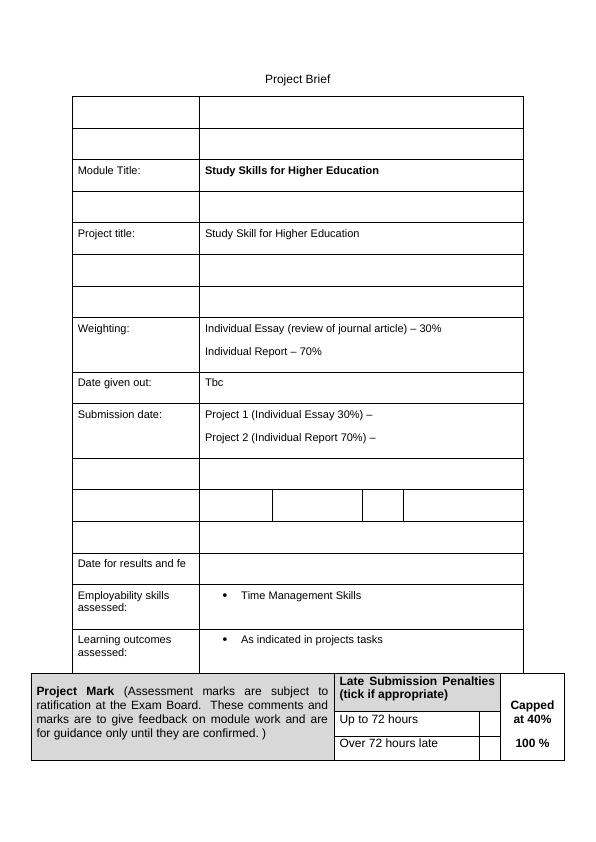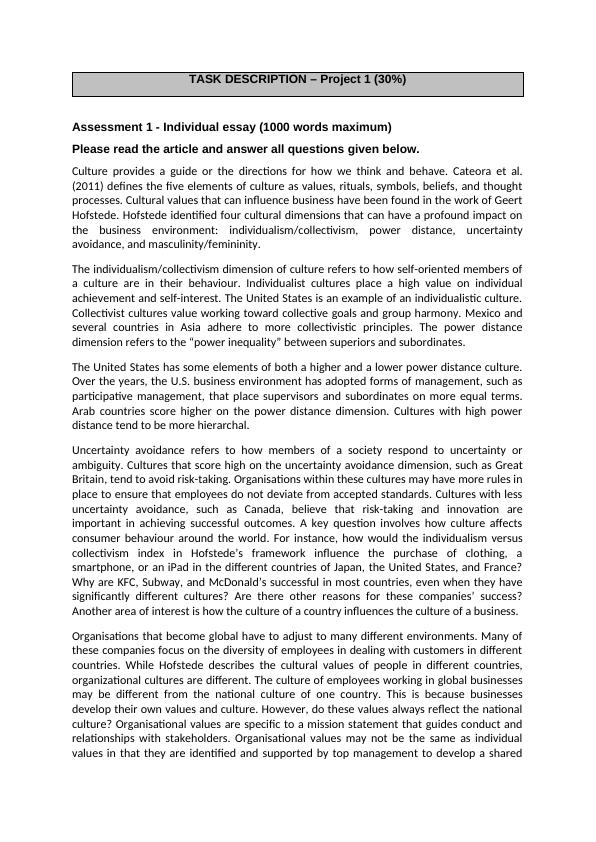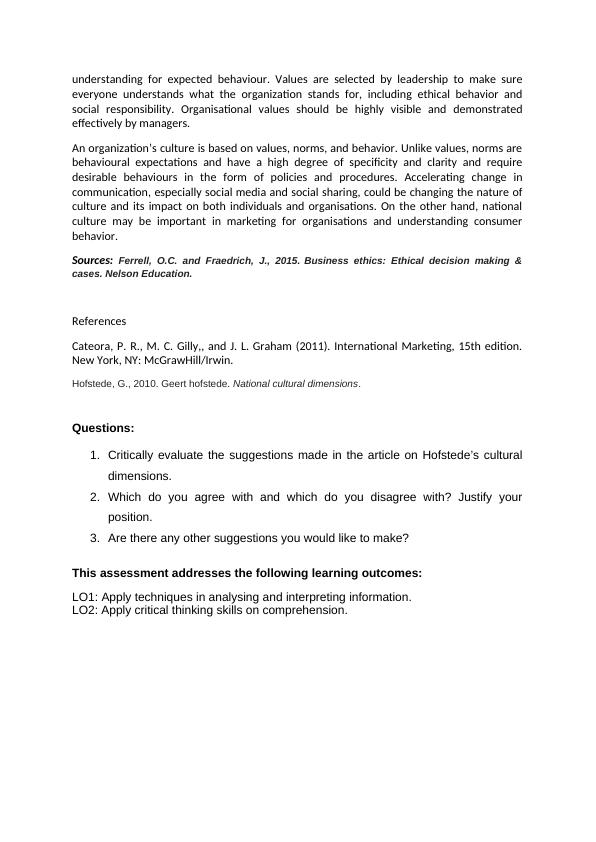Study Skills for Higher Education
Added on 2023-02-02
12 Pages2710 Words66 Views
Project Brief
Module Title: Study Skills for Higher Education
Project title: Study Skill for Higher Education
Weighting: Individual Essay (review of journal article) – 30%
Individual Report – 70%
Date given out: Tbc
Submission date: Project 1 (Individual Essay 30%) –
Project 2 (Individual Report 70%) –
Date for results and fe
Employability skills
assessed:
Time Management Skills
Learning outcomes
assessed:
As indicated in projects tasks
Project Mark (Assessment marks are subject to
ratification at the Exam Board. These comments and
marks are to give feedback on module work and are
for guidance only until they are confirmed. )
Late Submission Penalties
(tick if appropriate) Capped
at 40%
100 %
Up to 72 hours
Over 72 hours late
Module Title: Study Skills for Higher Education
Project title: Study Skill for Higher Education
Weighting: Individual Essay (review of journal article) – 30%
Individual Report – 70%
Date given out: Tbc
Submission date: Project 1 (Individual Essay 30%) –
Project 2 (Individual Report 70%) –
Date for results and fe
Employability skills
assessed:
Time Management Skills
Learning outcomes
assessed:
As indicated in projects tasks
Project Mark (Assessment marks are subject to
ratification at the Exam Board. These comments and
marks are to give feedback on module work and are
for guidance only until they are confirmed. )
Late Submission Penalties
(tick if appropriate) Capped
at 40%
100 %
Up to 72 hours
Over 72 hours late


TASK DESCRIPTION – Project 1 (30%)
Assessment 1 - Individual essay (1000 words maximum)
Please read the article and answer all questions given below.
Culture provides a guide or the directions for how we think and behave. Cateora et al.
(2011) defines the five elements of culture as values, rituals, symbols, beliefs, and thought
processes. Cultural values that can influence business have been found in the work of Geert
Hofstede. Hofstede identified four cultural dimensions that can have a profound impact on
the business environment: individualism/collectivism, power distance, uncertainty
avoidance, and masculinity/femininity.
The individualism/collectivism dimension of culture refers to how self-oriented members of
a culture are in their behaviour. Individualist cultures place a high value on individual
achievement and self-interest. The United States is an example of an individualistic culture.
Collectivist cultures value working toward collective goals and group harmony. Mexico and
several countries in Asia adhere to more collectivistic principles. The power distance
dimension refers to the “power inequality” between superiors and subordinates.
The United States has some elements of both a higher and a lower power distance culture.
Over the years, the U.S. business environment has adopted forms of management, such as
participative management, that place supervisors and subordinates on more equal terms.
Arab countries score higher on the power distance dimension. Cultures with high power
distance tend to be more hierarchal.
Uncertainty avoidance refers to how members of a society respond to uncertainty or
ambiguity. Cultures that score high on the uncertainty avoidance dimension, such as Great
Britain, tend to avoid risk-taking. Organisations within these cultures may have more rules in
place to ensure that employees do not deviate from accepted standards. Cultures with less
uncertainty avoidance, such as Canada, believe that risk-taking and innovation are
important in achieving successful outcomes. A key question involves how culture affects
consumer behaviour around the world. For instance, how would the individualism versus
collectivism index in Hofstede’s framework influence the purchase of clothing, a
smartphone, or an iPad in the different countries of Japan, the United States, and France?
Why are KFC, Subway, and McDonald’s successful in most countries, even when they have
significantly different cultures? Are there other reasons for these companies’ success?
Another area of interest is how the culture of a country influences the culture of a business.
Organisations that become global have to adjust to many different environments. Many of
these companies focus on the diversity of employees in dealing with customers in different
countries. While Hofstede describes the cultural values of people in different countries,
organizational cultures are different. The culture of employees working in global businesses
may be different from the national culture of one country. This is because businesses
develop their own values and culture. However, do these values always reflect the national
culture? Organisational values are specific to a mission statement that guides conduct and
relationships with stakeholders. Organisational values may not be the same as individual
values in that they are identified and supported by top management to develop a shared
Assessment 1 - Individual essay (1000 words maximum)
Please read the article and answer all questions given below.
Culture provides a guide or the directions for how we think and behave. Cateora et al.
(2011) defines the five elements of culture as values, rituals, symbols, beliefs, and thought
processes. Cultural values that can influence business have been found in the work of Geert
Hofstede. Hofstede identified four cultural dimensions that can have a profound impact on
the business environment: individualism/collectivism, power distance, uncertainty
avoidance, and masculinity/femininity.
The individualism/collectivism dimension of culture refers to how self-oriented members of
a culture are in their behaviour. Individualist cultures place a high value on individual
achievement and self-interest. The United States is an example of an individualistic culture.
Collectivist cultures value working toward collective goals and group harmony. Mexico and
several countries in Asia adhere to more collectivistic principles. The power distance
dimension refers to the “power inequality” between superiors and subordinates.
The United States has some elements of both a higher and a lower power distance culture.
Over the years, the U.S. business environment has adopted forms of management, such as
participative management, that place supervisors and subordinates on more equal terms.
Arab countries score higher on the power distance dimension. Cultures with high power
distance tend to be more hierarchal.
Uncertainty avoidance refers to how members of a society respond to uncertainty or
ambiguity. Cultures that score high on the uncertainty avoidance dimension, such as Great
Britain, tend to avoid risk-taking. Organisations within these cultures may have more rules in
place to ensure that employees do not deviate from accepted standards. Cultures with less
uncertainty avoidance, such as Canada, believe that risk-taking and innovation are
important in achieving successful outcomes. A key question involves how culture affects
consumer behaviour around the world. For instance, how would the individualism versus
collectivism index in Hofstede’s framework influence the purchase of clothing, a
smartphone, or an iPad in the different countries of Japan, the United States, and France?
Why are KFC, Subway, and McDonald’s successful in most countries, even when they have
significantly different cultures? Are there other reasons for these companies’ success?
Another area of interest is how the culture of a country influences the culture of a business.
Organisations that become global have to adjust to many different environments. Many of
these companies focus on the diversity of employees in dealing with customers in different
countries. While Hofstede describes the cultural values of people in different countries,
organizational cultures are different. The culture of employees working in global businesses
may be different from the national culture of one country. This is because businesses
develop their own values and culture. However, do these values always reflect the national
culture? Organisational values are specific to a mission statement that guides conduct and
relationships with stakeholders. Organisational values may not be the same as individual
values in that they are identified and supported by top management to develop a shared

understanding for expected behaviour. Values are selected by leadership to make sure
everyone understands what the organization stands for, including ethical behavior and
social responsibility. Organisational values should be highly visible and demonstrated
effectively by managers.
An organization’s culture is based on values, norms, and behavior. Unlike values, norms are
behavioural expectations and have a high degree of specificity and clarity and require
desirable behaviours in the form of policies and procedures. Accelerating change in
communication, especially social media and social sharing, could be changing the nature of
culture and its impact on both individuals and organisations. On the other hand, national
culture may be important in marketing for organisations and understanding consumer
behavior.
Sources: Ferrell, O.C. and Fraedrich, J., 2015. Business ethics: Ethical decision making &
cases. Nelson Education.
References
Cateora, P. R., M. C. Gilly,, and J. L. Graham (2011). International Marketing, 15th edition.
New York, NY: McGrawHill/Irwin.
Hofstede, G., 2010. Geert hofstede. National cultural dimensions.
Questions:
1. Critically evaluate the suggestions made in the article on Hofstede’s cultural
dimensions.
2. Which do you agree with and which do you disagree with? Justify your
position.
3. Are there any other suggestions you would like to make?
This assessment addresses the following learning outcomes:
LO1: Apply techniques in analysing and interpreting information.
LO2: Apply critical thinking skills on comprehension.
everyone understands what the organization stands for, including ethical behavior and
social responsibility. Organisational values should be highly visible and demonstrated
effectively by managers.
An organization’s culture is based on values, norms, and behavior. Unlike values, norms are
behavioural expectations and have a high degree of specificity and clarity and require
desirable behaviours in the form of policies and procedures. Accelerating change in
communication, especially social media and social sharing, could be changing the nature of
culture and its impact on both individuals and organisations. On the other hand, national
culture may be important in marketing for organisations and understanding consumer
behavior.
Sources: Ferrell, O.C. and Fraedrich, J., 2015. Business ethics: Ethical decision making &
cases. Nelson Education.
References
Cateora, P. R., M. C. Gilly,, and J. L. Graham (2011). International Marketing, 15th edition.
New York, NY: McGrawHill/Irwin.
Hofstede, G., 2010. Geert hofstede. National cultural dimensions.
Questions:
1. Critically evaluate the suggestions made in the article on Hofstede’s cultural
dimensions.
2. Which do you agree with and which do you disagree with? Justify your
position.
3. Are there any other suggestions you would like to make?
This assessment addresses the following learning outcomes:
LO1: Apply techniques in analysing and interpreting information.
LO2: Apply critical thinking skills on comprehension.

End of preview
Want to access all the pages? Upload your documents or become a member.
Related Documents
Hofstede’s Cultural Dimesnion and Five Bases of Powerlg...
|9
|2950
|83
Cultural Dimensions and Managing Organizational Culturelg...
|8
|1583
|205
Hofstede’s cultural dimension : Assignmentlg...
|12
|3664
|28
Importance of Hofstede's Cultural Dimensions on International Businesslg...
|6
|1202
|325
Hofetede's Cultural Dimensions Assignmentlg...
|6
|1270
|54
Study Skills for Higher Education (Doc)lg...
|7
|1269
|98
